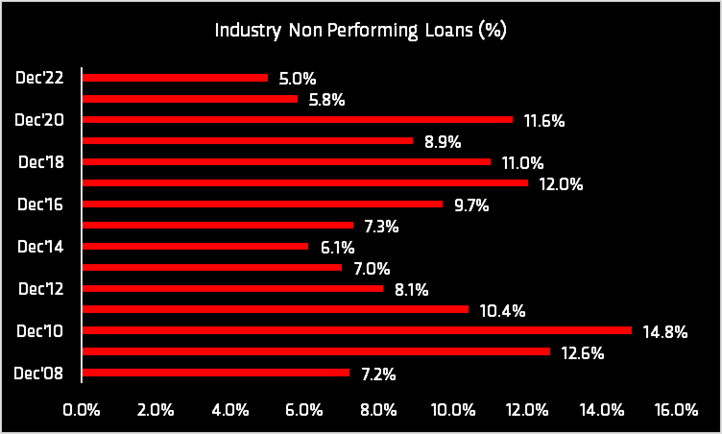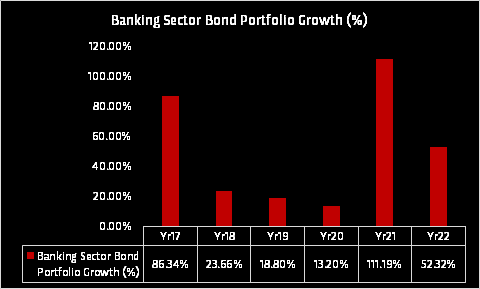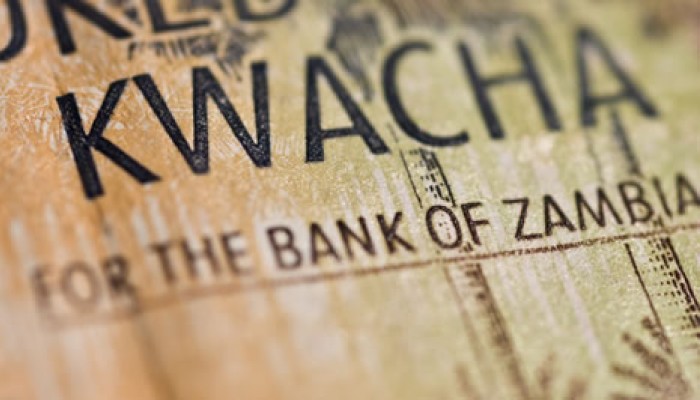Commercial banking bad loan stock for the year 2022 ebbed to a historical low of 5% according to Bank of Zambia sector financial statements. Non-performing loan stock in nominal terms infinitesimally fell by 0.76% to K2.6 billion year on years. The improvement in bad loan inventory was as a result of a central government bailout by the central bank of fiscal induced credit risk in accumulating arrears in the period 4Q20 to 3Q21. This intervention was step taken to absorb credit risk pressures in unpaid arrears to suppliers which deprived the market of liquidity. The de-risking saw the dismantling of domestic arrears with government securities, at a time when economic conditions had worsened from an array of factors ranging from fiscal vulnerabilities to an acute pandemic. Improvements in the ratio was also supported by strong credit growth by 18.2% (K8.2 billion) in FY22.
The bad loans ratio, as at December 2022, is 500 basis points below the 10.0% prudential threshold signaling an improvement from historic NPL highs of 14.8% (in 2010). See below the NPL trajectory from December 2008 to date.

The banking system in Africa’s second largest red metal hotspot has remained fairly resilient and proactive with a plethora of themes key of which include fiscal and pandemic induced vulnerabilities which have transmitted strains to the private sector. This resulted in the buildup of domestic arrears representing liquidity the private sector was deprived of. This marked the genesis of accumulation of non-performing loan stocks which weighed the banking system across. Arguably, the domestic debt quagmire has been tagged as political in nature but manifested in pockets of credit risk. Credit growth has over the years been marred by high-interest rates, a depiction of a fiscal posture of governments very systematic across the African continent as sovereigns tend to overcrowd the domestic credit markets to balance fiscal budgets.
In a note to clients, the Managing Partner of Zatu Financial Consultants, Munyumba Mutwale said, ”Record low NPL’s and bank earnings at a time of rising inflationary pressure, from elevated food prices and currency weakness, could likely see the central bank shift its monetary stance from dovish to hawkish should price pressures persist beyond the seasonal period of November to March. However, the signal by the central bank’s decision to raise reserve ratios already shows the central bank’s willingness to tame inflation.”
FISCAL AND MONETARY POLICY DISLOCATIONS
The disconnect between the fiscal and monetary policy was very pronounced in the era when debt stocks soared and this triggered various actions by the central bank to support the financial system. One key intervention was the bond buybacks dubbed a local restructuring of domestic debt through buying off shorter-dated securities and issuing long tenors to ease repayment obligation pressures.
Domestic arrears were also addressed by paying suppliers with government securities which allowed for discounting with local banks for cash to ease liquidity pressures. This was more pronounced in the pandemic period when credit markets required intervention. Subsequent arrears dismantling has helped eased pressure on suppliers helping improve the industry position. Zambia’s domestic arrears position is currently at K46 billion.


The drop in NPL also coincides with the rapid rise in secondary market bonds trading, banking sector bond holdings and bond issuances in the 2021/22 period as seen in the graph below.
This signals that the decline in NPL seems to have come from the government de-risking of the market as the suppliers who were paid in government securities then liquidated them with their banks thus inflating the bank bond portfolios. This simultaneously led to easing the bad loan profiles as bonds carry a much lower risk profile.
The period November 2020 to November 2021 saw a 44% plummet in industry NPL ratio.

MANUFACTURING, MINING AND HOUSING SPURRED LOAN GROWTH
Credit growth for 2022 was supported by a 92% growth in manufacturing, a 124% explosion in mining-related activity and a 204% sprint in mortgages that exceeded a billion Kwacha, a historical record seen in the market. The credit expansion in the three sectors aligns with Zambia’s industrial cycle. Some key impediments to credit growth could gravitate around delayed debt restructuring which is exerting pressure on the currency breeding inflation and could resulting in higher term funding costs.
The Kwacha Arbitrageur

